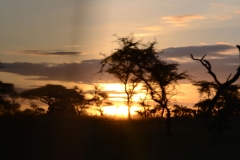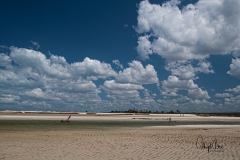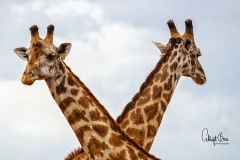










Tanzania’s second-largest national park after the Serengeti, Ruaha National Park is a remote bastion of spectacular wilderness, undisturbed wildlife, and breathtaking scenery. With herds of more than 10,000 elephants, vast concentrations of buffalo, gazelle, and over 400 bird species, Ruaha’s limitless wilderness, together with the surrounding game reserves of Rungwa and Kisigo – stretches over 40,000 square kilometres. Elephants are found in some of the highest concentration in the country, travelling in matriarch-lead herds through ancient grazing lands and seasonal supplies of water.
The Great Ruaha River is the main feature of the park, and meanders through its borders. On its banks, the game viewing is spectacular, whether done by land or by water. Hippos yawn under the midday sun and crocodiles lie lazily along the banks. Fish eagles dive and swoop along the riverbanks, and at night the sound of frogs croaking happily in the reeds extends across the hills and plains. Boating safaris are starting to gain in popularity, and provide a popular alternative to viewing the area by car.
Most of the national park is located on the top of a 900 metre plateau whose ripples of hills, valleys, and plains makes the game viewing topography beautifully unique. Small mountains run along the southwest borders of the park and their tree-covered slopes are visible in the distance. During the rainy seasons, dry river beds swell with the biannual deluge and within days, a thin coat of green covers all the land in sight.
Because of its rather remote location, Ruaha National Park is largely unexplored. Because of this, a safari to the national park often has the feel of a private adventure and an unique experience. For the intrepid wilderness lover and the avid safari explorer, a trip to Ruaha is uniquely rewarding and a perfect piece of Africa.
Best time to visit: The best months are June to February. From March to May, many tracks may be closed due to rains.
Getting there: Ruaha can be reach from Dar es Salaam by road in 10 hours or 1 hrs by a charter flight
Ruaha can be visited at any time of year, however the best time for game viewing is during the dry season from June to December when wildlife converges on the dwindling water reserves notably the river in front of the Lodge.Ruaha River Lodge Built out of local stone and thatch, the lodge is built around natural kopjes and capitalises on it’s exceptional position on a bend in the river
Ruaha River lodge is the only ‘lodge’ in the Ruaha, consisting of 24 stone chalets stretching along the river bank.
Each chalet has stunning views from a large veranda out the front, while the huge interiors feature a sitting area, writing desk and either twin or double beds. At the rear of each chalet is a large bathroom decorated with found timber, a shower and double basins.
The first dining area is a long banda by the side of the river. Breakfast is the perfect time to watch the game meander down for a drink, while evenings can be spent around the fire pit, looking down the river, or curled up in one of the sofas with a drink and a book.
The second area is imperiously-positioned atop the largest kopje in the area, situated on a bend, and enjoys commanding views down two sections of the river. This is surely the best sundowner spot in Ruaha.
Ruaha Hilltop Lodge is built on a hill with a wonderful panoramic view. There are many types of different birds, wild flowers, butterflies and trees that can be seen nearby.
Ruaha Hilltop Lodge is 100km from Iringa on the Iringa – Ruaha main road and 5km from Tungamalenga village and near the boundary of Ruaha National Park. Ruaha has one of Tanzania’s richest concentrations of animals, birds and plant life. Click here for a listing of birds that can be found around Ruaha Hilltop Lodge. The lodge stands on the slopes of Ideremle Mountain and the panoramic view is breathtaking. Jeeps are available for game drives as well as tours of Iringa.
The luxury self contained cottages are very comfortable and private, each with its own balcony with a beautiful view. Our water is heated by solar power. The reception, dining room and bar are all under one roof, with a gallery to enjoy the spectacular African sunrise and sunset. Giraffes, elephants and baboons and kudus can sometimes be glimpsed not far way.
The large verandahs are an ideal place for relaxing in between activities or simply to enjoy the view of wildlife passing by. Alternatively help yourself to complementary tea or coffee in the lounge, browse through our selection of wildlife books or make a purchase at our gift shop to support some of our community-development activities.
Twelve tents nestled in a spacious area under the shade of large sycamore figs and Faidherbia albida, spaciously located along the curving banks of the Mdonya sand-river. Each traditional safari tent is comfortably furnished, catering for solo travelers, couples or families. All the tents have ensuite bathrooms with dressing room, open-roofed solar heated shower and separate flush toilets.
Mdonya Old River Camp is located in the Ruaha National Park in Southern Tanzania ideally combinable with Selous but also accessible by plane from Katavi to the West and Arusha in the North of Tanzania. The game area here is very good and also accessible to the Mwagusi area which also very good.
The communal area at Mdonya is a simple tented dining area and lounge area with outdoor sitting area around a camp fire in the middle of the wilderness. A very simple but adventurous camp set up. Located right at the centre of a wilderness area, the dining and lounge tents are under sycamore fig trees overlooking the dry river bed, so sitting in the camp with a book and a pair of binoculars may be quite rewarding.